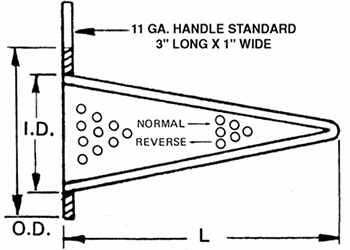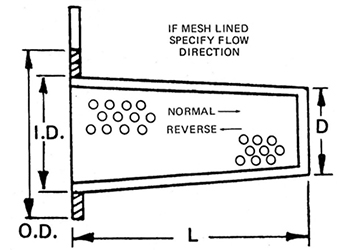Temporary strainers(often called temporary filters)are essential components in piping systems to protect valuable equipment from debris, dirt, and other foreign particles.
These filters are typically installed during the commissioning phase of pipelines or in temporary situations to filter out unwanted materials until the system stabilizes. After achieving a stable condition or once the initial debris load is removed, temporary filters are often replaced with permanent solutions or removed altogether.
Various types are available: temporary cone strainers, temporary basket strainers, and flat types. Each has its unique design and application, depending on the system's flow requirements, pressure, and filtration needs. Let's dive deeper into these three types.
Temporary Strainer Types
| Temporary Conical Strainer | Temporary Basket Strainer | Temporary Flat Strainer | |
| Picture |  |  |  |
| Description | The cone-type temporary strainer(Witches Hat Strainer) is designed with a conical shape to filter out large debris in the flow. It is typically placed upstream of pumps, compressors, and other sensitive equipment to prevent damage from particles that could enter the system during startup or repair work. Click here to learn about>> Witches Hat Strainer Flow Direction | The Basket Type Strainer is another popular design used in piping systems. As the name suggests, this strainer has a basket shape, offering a larger surface area for debris collection compared to the cone type. | A flat type is the simplest and most cost-effective type. It consists of a perforated flat sheet with holes or mesh for filtration. While not as common as cone or basket strainers, flat strainers serve a purpose in specific temporary applications. |
| Features | Shape: The conical shape allows for high dirt-holding capacity without significantly restricting the flow. Installation: Installed in-line between flanges of the pipeline | Shape: The cylindrical basket design provides a larger filtration area and can handle higher volume of debris. Installation: Like the cone type, the basket type is installed between flanges in the pipeline. | Shape: Flat plate design offers a basic form of filtration. Installation: Installed between flanges, just like the other types. However, it is the least intrusive and easy to install. |
| Advantages | Easy installation and removal, relatively low cost, and provides efficient protection during temporary operations. | The larger surface area allows for better dirt-holding capacity, making it ideal for pipelines where higher filtration capacity is needed. | Simple design, low cost, and easy to fabricate for temporary use. It also has minimal impact on the flow characteristics due to its simplicity. |
| Applications | Used in pipelines transporting gas, oil, or water. Suitable for startup operations where temporary filtration is necessary to remove large contaminants like welding slag, scale, or other construction debris. | Commonly used in large pipelines or systems with high flow rates. Ideal for applications where the debris load is anticipated to be heavy or consistent during the initial stages of operation. Used in industries such as petrochemical, oil & gas, and water treatment | Best for temporary filtration needs with low levels of debris. Used in low-flow systems where heavy filtration is not necessary or in short-term filtration operations during system testing. |
When selecting a temporary strainer for a specific application, several factors should be taken into account:
▪ Flow Rate: Consider the expected flow rate of the fluid to ensure that the strainer can handle the volume without causing excessive pressure drop.
▪ Particle Size: Determine the size of particles that need to be captured to select a strainer with the appropriate mesh size or perforation.
▪ Material Compatibility: Ensure that the strainer material is compatible with the fluid being processed to prevent corrosion or contamination.
▪ Installation and Maintenance: Consider ease of installation, removal, and maintenance requirements to minimize downtime and operational disruptions.
Contact us to custom-design temporary strainers!
Need to indicate: 1) Pipe size, 2) Pressure rating, 3) Performance or mesh size, 4) Material, 5) Style.